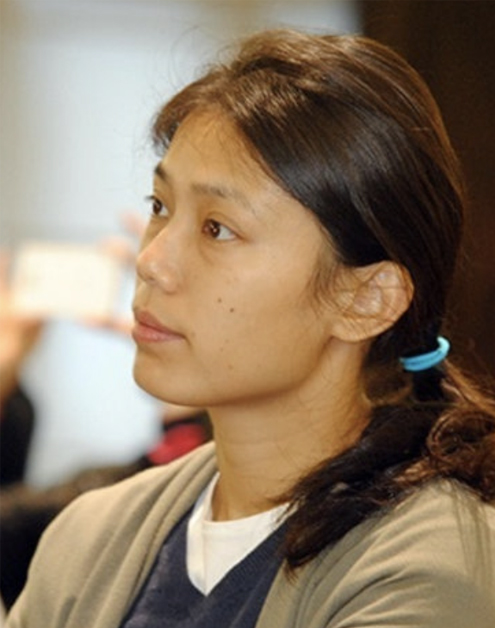ㅣSymposium 2

Prof. Philip Tseng & Yuhui Lo
Cross College Elite Program, National Cheng Kung University, Tainan, Taiwan
Hand Location Biases Visual Attention
Research has shown that when hands are positioned close to a visual target, the visual processing for such target is prioritized such that visual attentional processing is biased towards that region. This attentional prioritization produces faster search time in visual search, and produces better memory for the near-hand location in visual short-term memory (VSTM) task. In this study we used event-related potentials (ERP) along with multiscale entropy (MSE) analysis to shed light on the neural mechanism(s) behind such near-hand effect. Participants’ electroencephalogram (EEG) data were recorded as they performed a VSTM task with their hands either proximal or distal to the display. ERP analysis showed altered memory processing in the 400–700 ms time window during memory retrieval period. Additionally, MSE analysis also showed significant EEG difference between hand proximal and distal conditions between scales 10 to 20, and such difference is clustered around the right parietal cortex—a region that is involved in VSTM processing and bimodal hand-eye integration. Together, the findings around the parietal region support the bimodal neuron hypothesis, which states that the nearby hand effect is driven by the bimodal visuo-tactile neurons that prioritizes action-relevant regions and stimuli.

Prof. Yin-Hua Chen
Graduate Institute of Athletics and Coaching Science, National Taiwan Sport University, Taiwan
Action Anticipation in Baseball Players: A Series of Behavioral & fMRI Studies
To gain deeper insight into respective contributions of perceptual and motor experience of an observed action to anticipating its result, a series of studies were conducted to examine the perceptual anticipation of baseball batters (perceptual experts regarding pitching action) and pitchers (motor experts). Batters and pitchers at both skilled and intermediate levels were asked to make a decision about whether to swing the bat when viewing a series of videos showing incomplete sequences of a model pitcher throwing a strike or a ball. The behavioral results revealed that first 100 ms of ball flight could discriminate skilled batters from intermediate pitchers and batters (with no difference between intermediate pitchers and batters). Particularly, skilled batters, but not skilled pitchers, were statistically more accurate and less uncertain in making decisions than were intermediate players. Moreover, skilled batters demonstrated greater perceptual sensitivity in discriminating when to swing at strikes over balls than all other players. These findings suggested that when players were above intermediate level, perceptual experience of an observed action facilitated the perceptual anticipation to a greater extent than motor experience of producing it. The follow-up fMRI studies examined skilled batters and pitchers compared to non-players and replicated the previous behavioral findings. Furthermore, the action observation network, putamen, and cerebellum were found greatly involved during action anticipation no matter in players or controls. Pitchers showed higher activity than non-players in the left premotor cortex that has been implicated in the internal simulation of the observed action. Only batters exhibited differences in strike versus ball pitches in their left ventral extrastriate cortex, which might be associated with the processing of relevant visual information conveyed by the observed pitcher’s movement kinematics and pitch trajectory. Moreover, all groups showed higher activity selectively in the striatum, thalamus, sensorimotor cortex, and cerebellum during correct anticipations than incorrect ones, with most widespread activations in batters, reinforcing the greater involvement of the sensorimotor system in perceptual experience. The findings from these studies demonstrate that perceptual experience might enhance the action anticipation ability to a greater extent than motor experience, with overlapped but specific neural underpinnings.

Prof. Chin-An Wang
Shuang Ho Hospital, Taipei Medical University, Taiwan
Coordination of P300 and Skin Conductance Responses by Pupil-Linked Arousal in an Emotional Face-Word Stroop Task
The sudden appearance of a novel stimulus initiates a series of responses to orient the body for appropriate actions for survival, and these orienting responses involve changes in brain and bodily signals such as P300 and galvanic skin responses. Moreover, pupil size is a non-invasive index for arousal, arguably mediated by the locus coeruleus-norepinephrine (LC-NE) system, that could affect both EEG and galvanic skin responses. However, research on the coordination between P300 and galvanic skin response responses in the context of arousal fluctuation is limited. In this study, we investigate relationships between P300 (specifically P3a) and galvanic skin responses mediated by pupil-linked arousal. To do this, we simultaneously recorded electroencephalography, galvanic skin response and pupil size signals while subjects performed an emotional face-word Stroop task. Lower accuracy and slower reaction times as well as larger pupil dilation were obtained in the incongruent (face emotion expression and emotional word were unmatched), compared to the congruent condition. More importantly, P3a was modulated by pupil dilation size, with larger P3a obtained from the frontal scalp between the large and small pupil dilation conditions. Moreover, trial-by-trial correlations between pupil dilation and P3a amplitude were observed, with larger pupil dilation correlating with larger P3a amplitude in the incongruent condition. Furthermore, pupil dilation correlated with galvanic skin response on a trial-by-trial basis. Together, our results demonstrated that trial-to-trial fluctuations in arousal indexed by pupil dilation, correlated with P3a and galvanic skin responses. Because a tight coupling between pupil dilation and LC responsivity has been demonstrated in this task, the LC-NE system is likely involved in this coordination.


Prof. Chun-Hsien Hsu & Ting-Hsin Yen
Institute of Cognitive Neuroscience, National Central University, Taiwan
Comparing temporal response functions between native speakers and second language learners during naturalistic comprehension
Unlike conventional event-related potentials which estimate the averaged EEG activity to a set of stimuli, temporal response function (TRF) is a linear model to map between brain responses and features of a sensory stimulus. The TRF method allows the analysis of EEG signals during natural story comprehension. Studies have demonstrated that EEG activity to naturalistic speeches tracks the categorical processes of phonemes, syntactic surprisal, word onsets, lexical frequency, speech envelopes, etc. In the meantime, there are a large population using English as a second language in modern society. Therefore, how non-natives comprehend foreign languages is a growing interest. This study aimed to use TRF to decode the differences of neural responses induced by continuous speech in English native speakers (Natives) and Mandarin native speakers who learn English as their second language (ESLs). Two EEG datasets were compared according to the mother tongue of participants. Spoken stimuli and EEG data of thirty-three English native speakers were accessed from the Alice datasets. Another dataset was EEG data collected from twenty-six Mandarin Chinese speakers who learn English as their second language at Taiwan. Participants were instructed to passively listen to the audiobook of the first chapter of Alice’s Adventures in Wonderland and to answer a content-related comprehension questionnaire afterwards. In TRF analyses, predictors were speech envelope, word onsets, and grammatical classes. TRF model was estimated using the cross-validation procedure with each participant’s EEG data. Mass-univariate analyses were applied to evaluate the significance of TRF models. The results showed that ESLs generally yielded prolonged and delayed TRFs as compared to the natives. These results indicated that comprehending speeches in the second language might require more effort to parse linguistic information. In future works, TRFs might be helpful to evaluate the linguistic competence during language acquisition.
